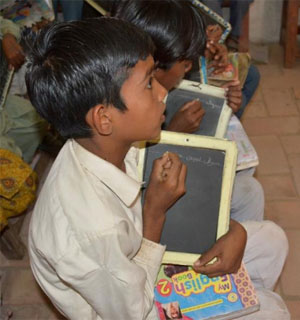It was a dream-come-true for the students and teachers at Government Primary School Sringwari in District Tharparkar. The only classroom of the school had new benches and a running fan – something the children in the remote village of Sringwari had wanted for years. The fan not only provided a degree of relief from the scorching heat of 48 C but also helped in keeping flies and mosquitoes away.
“Now that the classroom has a fan and is properly lit. I am confident about increased enrollment as well as retention of students because of this measure”, says Sajan Das who teaches at the school. The school, like 96 percent[1] of 4,010 schools in the district, did not have an electricity connection until recently and received a solar power system from Sukaar Foundation with the financial support of Ambassador’s Fund Grant Program (AFGP).
There are 60 students – 40 boys and 20 girls – enrolled in the school up to fifth grade. All students sit together in a single room. “The number of students dropped during summers every year”, tells Sajan Das, “Summer means hot winds, dry weather, and lots of flies and mosquitos with temperature going up to 52 C making it extremely difficult for children to attend classes.”

Lack of electricity is one of the major reasons for high dropout of schoolchildren. “The students have to sit six to seven hours a day in hot and dark classrooms without a fan or lighting. They sweat, feel suffocated and dizzy, and ultimately a significant number of students drop out”, Sajan shares.
This situation prompted the Sukaar Foundation to initiate and implement a five-month project titled “Renewable Energy Solutions for Girls and Mixed Schools” for which it received funding from AFGP.
In addition to Sajan’s school in Goth Sringwari, Sukaar Foundation has installed solar power systems with fans and bulbs in 19 schools in Mithi and Islamkot tehsils of Tharparkar. Approximately 2,088 students (including 789 girls and 1,299 boys) are benefitting from the solar systems.

With the installation of fans and lights in the schools, the students can take lessons without opening windows which used to let flies and mosquitoes come inside the classrooms. This has helped improve the students’ attendance and performance.
The initiative also encouraged the local community and the School Management Council to run a fundraising campaign for purchasing new furniture for the school.
[1] Press Reader, “Tharpakar tops list of districts with shut schools,” March 20, 2018, by Imtiaz Dharani
(https://www.pressreader.com/pakistan/daily–messenger/20180320/281792809561821)




















